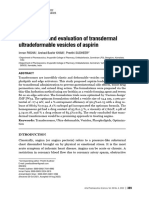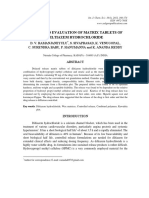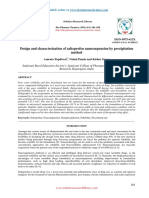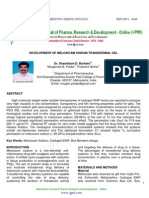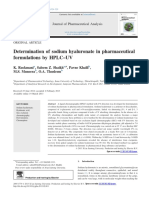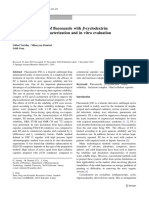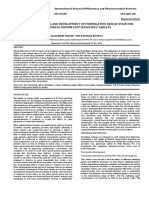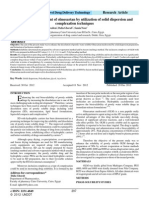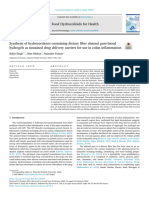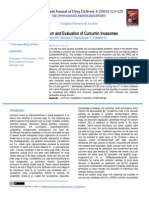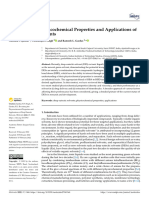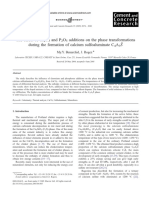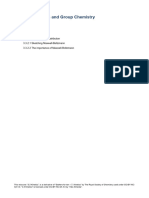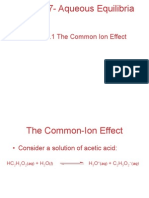Diltizem Microsphere
Diltizem Microsphere
Uploaded by
doddadineshCopyright:
Available Formats
Diltizem Microsphere
Diltizem Microsphere
Uploaded by
doddadineshOriginal Title
Copyright
Available Formats
Share this document
Did you find this document useful?
Is this content inappropriate?
Copyright:
Available Formats
Diltizem Microsphere
Diltizem Microsphere
Uploaded by
doddadineshCopyright:
Available Formats
Acta Poloniae Pharmaceutica Drug Research, Vol. 65 No. 2 pp.
249259, 2008
ISSN 0001-6837 Polish Pharmaceutical Society
PHARMACEUTICAL TECHNOLOGY
EVALUATION OF DILTIAZEM HYDROCHLORIDE-LOADED MUCOADHESIVE MICROSPHERES PREPARED BY EMULSIFICATION-INTERNAL GELATION TECHNIQUE
MALAY K. DAS* and DIVYA P. MAURYA Department of Pharmaceutical Sciences, Dibrugarh University, Dibrugarh 786004, India
Abstract: The problems of frequent administration and variable low bioavailability (40-60%) after oral administration of conventional dosage forms of diltiazem can be attenuated by designing it in the form of mucoadhesive microspheres which would prolong the residence time at the absorption site to facilitate intimate contact with the absorption surface and thereby improve and enhance the bioavailability. Diltiazem-loaded mucoadhesive microspheres were successfully prepared by emulsification-internal gelation technique with a maximum incorporation efficiency of 93.29 0.26%. The scanning electron microscopic study indicated that the microspheres were spherical in shape and the drug remained dispersed in the polymer matrix at amorphous state, which was further confirmed by x-ray diffraction analysis. The in vitro wash-off test indicated that the microspheres had good mucoadhesive properties. The wash-off was faster at simulated intestinal fluid (phosphate buffer, pH 7.4) than that at simulated gastric fluid (0.1 M HCl, pH 1.2). The in vitro drug release mechanism was non-fickian type controlled by swelling and relaxation of polymer. There was no significant change in drug content and cumulative drug release of drug-loaded microspheres stored at different storage condition after 8 weeks of study. Keywords: diltiazem hydrochloride, mucoadhesive microspheres, emulsification-internal gelation technique, barium carbonate, in vitro wash off test, non-fickian release
Diltiazem hydrochloride, a calcium channel blocker, is widely used for the treatment of angina pectoris, hypertension and arrhythmias. It is administered orally (tablets, capsules, sustained release tablets/capsules) and parenterally (intravenous). The usual dose of diltiazem is 180-240 mg/day. The conventional tablet and capsule is administered 3 or 4 times a day due to its short biological half-life of about 6 h. The problems of frequent administration and variable low bioavailability (40-60%) after oral administration of conventional tablet or capsules have been attenuated by designing diltiazem in the form of sustained release tablet or capsules. The sustained release forms are administered two times a day due to its limited residence time in the gastrointestinal tract. The mucoadhesive microcapsules of diltiazem would prolong the residence time at the absorption site to facilitate intimate contact with the absorption surface and thereby improve and enhance the bioavailability. The previous studies (1-3) reported the mucoadhesive drug delivery systems of diltiazem in the form of tablets for oral route and transdermal
patches; however, there is no report on mucoadhesive microcapsules. Therefore, the objective of the present study was the development and evaluation of gastroretentive microspheres containing diltiazem hydrochloride using various mucoadhesive polymers for prolonged gastrointestinal absorption. An attempt was also made to develop microspheres with high entrapment efficiency. The method of microencapsulation is based on emulsification-internal gelation technique involving alginate polymers alone and/or in combination with other mucoadhesive polymers. The method was successfully used to encapsulate labile biological materials such as DNA and proteins for immobilization (4-6). Encapsulation of bioactive compounds, such as proteins and DNA, by either internal gelation or external gelation revealed that internal gelation provides a better encapsulant protection from hydrolysis (7) but may permit higher losses from microspheres (5). Diltiazem hydrochloride is a water-soluble cardiovascular drug. The use of external gelation process of microencapsulation involving alginate polymers in the aqueous cross-linking agent would
* Corresponding author: e-mail: du_mkd@yahoo.co.in, Phone: +91-3732310052 (R), +91-3732370254 (O), Fax: +91-3732370323 (O).
249
250
MALAY K. DAS and DIVYA P. MAURYA et al.
alone and in combination with HPMC and carbopol 934 P. The homogeneous polymer(s) solution was prepared in distilled water stirred magnetically with gentle heat. The drug and cross-linking agent were added to the polymer solution and mixed thoroughly by stirring magnetically to form a viscous dispersion which was then extruded through a syringe with a needle of size no. 23 into light liquid paraffin containing 1.5% span 80 and 0.2% glacial acetic acid being kept under magnetic stirring at 100 rpm. The microspheres were retained in the light liquid paraffin for 30 min to produce rigid discrete particles. They were collected by decantation and the product thus separated was washed with chloroform to remove the traces of paraffin oil. The microspheres were dried at 40OC under vacuum for 12 h. The compositions of the microspheres formulations are listed in Table 1. Assay of diltiazem hydrochloride Diltiazem content in the microcapsules was estimated by a UV-spectrophotometric method based on the measurement of absorbance at 236 nm in phosphate buffer of pH 7.4. The method was validated for linearity, accuracy and precision. A linear relationship was obtained between the concentration ranges of 5 25 mg/mL. The linear regression equation of the calibration curve was:
Absorbance = concentration 0.0603 0.0287 (R2 = 0.999)
minimize the entrapment efficiency due to the diffusion of diltiazem hydrochloride into the aqueous phase during the curing of the gel beads. The other inconveniences include the limitation in reducing microspheres diameter, the teardrop shape of the microparticles produced and difficulty in industrial scale-up (8). The emulsification-internal gelation technique of microencapsulation use an external oil phase and thereby may reduce the drug diffusion during encapsulation process and improve the drug entrapment efficiency. The gel bead diameter can be easily controlled and that has scale-up potential (9). EXPERIMENTAL The following chemicals and solvents were used: diltiazem hydrochloride (a gift sample from Cipla Ltd., Mumbai), sodium alginate, (hydroxypropyl)methyl cellulose (HMPC) and carbopol 934P (Loba Chemie Pvt. Ltd., Mumbai), barium carbonate, chloroform, hydrochloric acid and glacial acetic acid (Ranbaxy Fine Chemicals, Chandigarh), light liquid paraffin, Span 80 (Central Dug House, New Delhi), sodium hydroxide pellets (Qualigens Fine Chemicals, New Delhi), potassium dihydrogen phosphate (Merck Ltd. Mumbai). All the solvents and chemicals used were of analytical grade satisfying pharmacopoeial standards. Preparation of microspheres Microspheres containing diltiazem hydrochloride were prepared employing sodium alginate
The very low value of intercept indicates its negligible deviation from the origin. The low value of mean standard error (0.4%) and relative standard devia-
Table 1. Composition of diltiazem hydrochloride-loaded various mucoadhesive microspheres formulations.
F.N.Codes FA FB FC FD FE FF FG FH FI
Polymer level (% w/v) Sodium alginate, 2% Sodium alginate, 3% Sodium alginate, 4% Sodium alginate, 2% + HPMC, 1% Sodium alginate, 3% + HPMC, 1% Sodium alginate, 4% + HPMC, 1% Sodium alginate, 2% + carbopol, 1% Sodium alginate, 3% + carbopol, 1% Sodium alginate, 4% + carbopol, 1%
Drug level (%w/w) 5 5 5 5 5 5 5 5 5
Cross-linking agent/level (%w/w) BaCO3 / 6% BaCO3 / 6% BaCO3 / 6% BaCO3 / 6% BaCO3 / 6% BaCO3 / 6% BaCO3 / 6% BaCO3 / 6% BaCO3 / 6%
Evaluation of diltiazem hydrochloride-loaded mucoadhesive...
251
Table 2. Incorporation efficiency and particle size of diltiazem hydrochloride-loaded microspheres.
F. N. Codes FA FB FC FD FE FF FG FH FI
Incorporation efficiency (mean SD) mm 63.16 0.40 79.31 0.57 83.79 0.46 81.46 0.30 82.57 0.29 93.29 0.26 70.80 0.40 68.00 0.35 87.70 0.10
Particle size (mean SD) mm 807.95 6.5 876.30 9.0 1007.86 11.6 851.00 9.3 882.30 4.6 913.00 4.66 884.59 7.0 940.60 3.7 908.47 4.2
tion (0.5%) confirmed the accuracy and precision of the method. Physical characterization of microspheres Incorporation efficiency The amount of diltiazem present in the microspheres was determined by extracting the drug into phosphate buffer of pH 7.4 under magnetic stirring for a period of 2 h. The solution was filtered through Whatman filter paper no.5, suitably diluted and estimated for drug content spectrophotometrically at 236 nm using Hitachi U-2001 UV-VIS spectrophotometer. The incorporation efficiency was calculated by the following formula: Incorporation efficiency (%) = Experimental drug content 100 / Theoretical drug content. Size distribution of microspheres The size of the microspheres was determined using an optical microscope (Olympus, Japan) fitted with an ocular micrometer. The ocular micrometer was calibrated with a stage micrometer. The mean diameter reported was obtained from a total of more than 100 microspheres. Scanning electron microscopy (SEM) The shape and surface morphology of the drugloaded microspheres were investigated by using JEOL, JSM-6360, scanning electron microscope at 20 kV. Prior to examination samples were gold coated under vacuum (Fine coat, ion sputter, JFC1100) to render them electrically conductive. The surface morphology of the microspheres collected after dissolution studies were also investigated. Mucoadhesive property of microspheres The mucoadhesive property of the microspheres was evaluated employing the method
described by Lehr et al. (10) with slight modification. The mucoadhesiveness of microspheres was compared with that of a nonbioadhesive material, ethyl cellulose microspheres. The test was performed at both simulated gastric fluid (0.1 M HCl, pH 1.2) and simulated intestinal fluid (phosphate buffer, pH 7.4). The freshly excised pieces of intestinal mucosa (2 3 cm) from goat were mounted onto glass slides (3 1 inch) with cyanoacrylate glue. About 50 microspheres were spread onto each wet rinsed tissue specimen and immediately thereafter the slides with suitable support were hung onto the arm of a USP tablet disintegrating test machine. When the disintegrating test machine was operated, the tissue specimen was given a slow, regular up and down movement in the test fluid at 37OC contained in a 1-liter vessel. At different time intervals up to 8 h the machine was stopped and the number of microspheres still adhering to the tissue was counted. X-ray diffraction analysis The x-ray diffractometry was carried out to investigate the effect of microencapsulation process on crystalinity of the drug. The study was carried out using an x-ray diffractometer (Seifert, Model 3000 P, Germany). The pure diltiazem hydrochloride powder, blank and drug-loaded microspheres in powder form were scanned from 10O to 60O diffraction angle (2q) range under the following measurement conditions: source, nickel filtered Cu-Ka radiation; voltage, 35 kV; current, 25 mA; scan speed, 0.05 min-1. In vitro release study The United States Pharmacopoeia basket-type dissolution rate test apparatus was used for all the in vitro release studies. An accurately weighed quantity of the microspheres (100 mg) was suspended in
252
MALAY K. DAS and DIVYA P. MAURYA et al.
900 mL of phosphate buffer of pH 7.4. The dissolution medium was stirred at 50 rpm and maintained at constant temperature (37 0.5OC). At preset time intervals, 5 mL aliquots were withdrawn and replaced by an equal volume of fresh prewarmed dissolution medium maintaining sink condition throughout the experiment. After suitable dilution, the samples were analyzed for drug content at 236 nm using Hitachi U-2001 UV-VIS spectrophotometer. The concentration of diltiazem in samples were calculated using regression equation of the calibration curve of diltiazem in phosphate buffer of pH 7.4 and corrected to compensate the loss due to sample withdrawal, using the equation proposed by Hayton and Chen (11). Stability study The drug-loaded microspheres were stored at various storage conditions (room temperature, 37OC and 45OC/75% RH) in airtight sealed vials. The drug content of the microspheres was determined at regular time intervals and the drug release profiles were studied at 0 and 60 days. RESULTS AND DISCUSSION Preparation of microspheres Diltiazem-loaded mucoadhesive microspheres were prepared by emulsification-internal gelation technique. Diltiazem hydrochloride, a hydrophilic drug, can partition out into the aqueous processing phase during the preparation of microspheres by external gelation method. Depending on the processing conditions as much as 80 90% of the drug can partition out into the external aqueous processing medium. In this study attempt was made to encapsulate diltiazem hydrochloride with sufficiently high encapsulation efficiency. An external oil phase (liquid paraffin) was used as the harvesting medium with the expectation that for diltiazem hydrochloride it would be nonfavorable to diffuse out of the microspheres before they form as rigid and discrete particles. The emulsification-internal gelation technique use an oil soluble acid (0.2% glacial acetic acid) in the external oil phase, which diffuse through the oilwater interface into the polymeric dispersed globules containing barium carbonate, resulting in the release of free Ba2+. The sodium ion (Na+) of alginate is exchanged with Ba2+ initiating gelation reaction to form barium alginate gel beads. Physical characterization of microspheres Diltiazem-loaded mucoadhesive microspheres composed of alginate alone and in combination with
Figure 1. SEM photomicrograph of drug-loaded (a) sodium alginate microsphere, (b) sodium alginate-HPMC microsphere, (c) sodium alginate-carbopol 934 microsphere.
HPMC and carbopol were prepared by the emulsification-internal gelation technique. The microspheres were found to be discrete, spherical, free flowing and of the monolithic matrix type. The microspheres were uniform in size with a mean size range of 807.95 6.5 to 1007.86 11.6 mm which fall in the arbitrary particle size range of 5 5000 mm (12, 13). The particle size ranges are shown in Table 2. The size of the microspheres was in
Evaluation of diltiazem hydrochloride-loaded mucoadhesive...
253
Figure 2. Mucoadhesion behavior of microsphere formulations (FA FC) in 0.1 M HCl, (pH 1.2) and phosphate buffer, (pH 7.4) medium.
Figure 3. Mucoadhesion behavior of microsphere formulations (FD FF) in 0.1 M HCl, (pH 1.2) and phosphate buffer, (pH 7.4) medium.
254
MALAY K. DAS and DIVYA P. MAURYA et al.
increasing trend with increasing the alginate concentration. This may be due to the increase in viscosity, which in turn increases in droplet size during addition of the polymer dispersion to the harvesting medium. The use of oil soluble surfactant (Span 80) permits the remarkable reduction in size of alginate gel beads as the result of decreasing the interfacial tension and preventing the droplets coalescence. The SEM photomicrographs (Figure 1) indicated that the microspheres were spherical in shape having particle size of 200 mm and the drug remained dispersed in the polymer matrix at amorphous state. Table 2 and SEM photomicrographs in Figure 1 reveal that the mean microspheres size as observed by optical microscope is significantly higher than that observed under scanning electron microscope. It might be explained by the fact that the incompletely dried microspheres (remaining at swollen state) were observed under optical microscope, whereas the microsphere particles were fully dried when SEM study was performed. The effects of alginate concentrations and polymer compositions on the drug incorporation efficiency of microspheres are shown in Table 2. The highest incorporation efficiency (93.29 0.26%) was achieved with 4% w/v sodium alginate in combination with 1% HPMC, which is followed by 4% w/v sodium alginate in combination with 1% w/v carbopol (loading efficiency 87.70 0.10%). Three different concentrations of sodium alginate (2%, 3% and 4%) were used. The higher incorporation efficiency was observed as the concentration of alginate increased. This may be attributed to the greater availability of active bariumbinding sites in the polymeric chains and consequently the greater degree of cross linking as the quantity of sodium alginate increased, resulting in the formation of nonporous microspheres. The drug loading efficiency greatly improved when alginate was blended with carbopol at 1% level. Mucoadhesive property of microspheres The microspheres consisting of sodium alginate alone and in combination with HPMC and carbopol exhibited good mucoadhesive properties as observed in in vitro wash-off test when compared to a nonmucoadhesive polymer, ethyl cellulose microspheres. The washoff was slow in the case of microspheres consisting of alginate-mucoadhesive polymers
84 1.15 82 1.15 88 1.0 90 0.58 92 0.57 96 1.0 100 100 82 90 0.57 96 0.57 920.57 98 100 100 100 FH
64 0.57 56 1.15
78 1.1 74 1.15
78 0.57 72 1.1
88 0.57 84 0.57
92 1.1 76 0.57
98 1.0 88 0.57
90 1.1 78 0.57 92 1.0 92 1.17 92 1.0 92 0.57 92 0.5 98 80 0.57 82 90 94 1.0 96 1.0 96 0.57 100 100 FI
72
90 1.15
82 1.15
84 0.57
In phosphate buffer (pH 7.4)
94 1.0
100
100
74
92
84 0.57
80 0.57
94 0.57
90 1.0
94 1.0
100
100
88 1.52
Percentage of microspheres adhered to mucosa of goat intestine SD (n = 3)
94 0.57
94 1.15
92 1.0
96 1.5
100
100
76 0.57 100 98 0.57 96 0.57
82 1.15 100 98 0.57 96 0.58
100 98 0.5 98 0.588
98 1.0
100
100
94
100 98 1.0
100
100
100
Time (h)
100
86 0.57 86 0.57 100
78 1.15 74 1.15 100
80 1.0
56 1
72
62 1.15
84 1.1
84 1
80
82
Table 3. Results of in-vitro wash-off test of diltiazem hydrochloride-loaded microspheres.
90 0.57 84 0.57
98 0.57 96 1.15 92 0.57
76 1.1 70 0.57 64 0.57
86 1.15
90 1.15
In 0.1 M HCl (pH 1.2)
88 1.0
82
90 0.58 88 1.0
94 1
98
82
98 0.57
90 0.57
96 1
96
94 90 0.57 90 0.57
100 96 0.57 90 0.57
98 1.15
96 1
100
100
92 1
100
84
100
98
100
100
100
100
98
Formulation
Codes
FA
FD
FG
98
EC
FB
FC
FE
FF
85
53
11
Evaluation of diltiazem hydrochloride-loaded mucoadhesive...
255
Figure 4. Mucoadhesion behavior of microsphere formulations (FG-FI) in 0.1 M HCl, (pH 1.2) and phosphate buffer, (pH 7.4) medium.
when compared to that of ethyl cellulose microspheres (Table 3). The wash-off was faster at simulated intestinal pH (7.4) than that at simulated gastric pH (1.2). Robinson et al. (14) reported that the solubility, hydration and mucoadhesivity of the polymers depend on the pH of the medium. The rapid wash-off observed at simulated intestinal pH may be due to the ionization of carboxyl acid group and other functional groups in the polymers, which increase their solubility and reduce adhesive strength. The results of the wash-off test indicated that the microspheres had fairly good mucoadhesive properties. Our result is supported by the report of Chowdary and Rao (15) who used the microcapsules of glipizide with a coat consisting of alginate and a mucoadhesive polymer sodium carboxymethyl cellulose, methyl cellulose, carbopol and (hydroxypropyl)methyl cellulose. The mucoadhesive behaviors of various microsphere formulations are shown in Figures 2 4. The developed mucoadhesive microspheres would adhere to the GI walls, thus resisting gastric emptying. It would ensure the prolong residence time at the absorption site to facilitate intimate contact with the absorption surface and thereby improve and enhance the bioavailability (16). In vitro drug release The in vitro drug release studies were carried out in the simulated gastric fluid (0.1 M HCl, pH 1.2) and simulated intestinal fluid (phosphate buffer, pH 7.4). The microspheres were prepared by ionic internal gelation technique using BaCO3 as crosslinking agent. The microspheres cross-linked with Ba2+ showed delay in disintegration and consequently a slow release of drug was obtained. It can be explained with the fact that the large size of barium ions (1.74 ) produced a hard and nonporous microspheres. Therefore, the exchange of Ba2+ ions in the microspheres with Na+ ions of the phosphate buffer and their removal as insoluble barium phosphate was obstacled and attributed as delayed swelling of the microspheres and slow release. Our results are in good agreement with the report of Das and Senapati (17) who used the alginate microspheres containing furosemide prepared by the ionic external gelation technique using BaCl2. Sodium alginate at three different concentrations (2%, 3% and 4% w/v) alone and in combination with 1% w/v of HPMC and/or carbopol 934 P was utilized for the preparation of microspheres. The drug release behaviors are shown in the Figures 5 7. It was observed that the amount of drug release decrease with an increase in the concentra-
Figure 5. Effect of concentration of polymer on drug release pattern of microspheres in 0.1 M HCl, (pH 1.2) and in phosphate buffer, (pH 7.4) for the formulations FA, FB and FC.
Table 4. Values for release exponent (n) and coefficient for determination (r2) derived from Mt / M = Ktn kinetic model.
F. N. Codes FA FB FC FD FE FF FG FH FI
n 0.528 0.896 0.670 0.780 0.782 0.552 0.641 0.880 0.590
r2 0.929 0.960 0.998 0.885 0.910 0.964 0.917 0.897 0.920
256
MALAY K. DAS and DIVYA P. MAURYA et al.
Figure 6. Effect of concentration of polymer on drug release pattern of microspheres in 0.1 M HCl, (pH 1.2) and in phosphate buffer, (pH 7.4) for the formulations FD, FE and FF.
Figure 7. Effect of concentration of cross-linking agent on drug release pattern of microspheres in 0.1 M HCl, (pH 1.2) and in phosphate buffer, (pH 7.4) for the formulations FG, FH and FI.
tion of sodium alginate. It can be attributed to an increase in the densities of the polymer matrix resulting in larger microspheres and this in turn increase the diffusion path length, which the drug molecules have to be traverse (18). It was observed that alginate microspheres had swollen more in phosphate buffer of pH 7.4 than in 0.1 M HCl (pH
1.2). Therefore, the release would depend on diffusion of diltiazem through the insoluble matrix of alginate polymer in 0.1 M HCl and a sustained drug release behavior was observed. In contrast, swelling and erosion of the microspheres prepared from alginate polymer was observed in phosphate buffer of pH 7.4. Slow erosion of barium cross-linked algi-
Evaluation of diltiazem hydrochloride-loaded mucoadhesive...
257
Table 5. The results of drug content (%) for drug-loaded microspheres at various storage conditions.
Storage conditions
Time (weeks) FB 0 90.26 89.52 88.12 90.26 87.89 87.02 90.26 84.71 79.61 4 8 0
Formulation Codes FE 87.24 85.10 82.00 87.24 84.12 80.79 87.24 81.01 78.05 FH 75.00 73.5 71.01 75.00 70.89 65.08 75.00 68.12 63.17
Room temperature
37OC
4 8 0
45 C/ 75%RH
O
4 8
>
>
Figure 8A. SEM photomicrographs of drug-loaded sodium alginatecarbopol 934 P microspheres (a) after dissolution in 0.1 M HCl of pH 1.2 and (b) after dissolution in phosphate buffer of pH 7.4.
Figure 8B. SEM photomicrographs of drug-loaded sodium alginate-HPMC microspheres (a) after dissolution in 0.1 M HCl of pH 1.2 and (b) after dissolution in phosphate buffer of pH 7.4.
nate microspheres could occur through slight degradation of alginate backbone into smaller fragments. In addition, the exchange of Ba2+ ions in the microspheres with Na+ ions of the phosphate buffer causes the sustained erosion of the microspheres, which greatly increase the drug release rate in phosphate
buffer of pH 7.4. To retard or sustain the drug release from the microspheres, (hydroxypropyl) methyl cellulose and carbopol 934P were blended with the alginate matrix. The microspheres retained their spherical shape after dissolution experiment in 0.1 M HCl.
258
MALAY K. DAS and DIVYA P. MAURYA et al.
with HPMC and/or carbopol lose their spherical shape after dissolution experiment. The microspheres were collected from the dissolution medium and dried at 40OC under vacuum for 12 h. The microspheres samples were then completely dried under vacuum and gold coated before performing the SEM study. The surface of the microspheres after dissolution experiment showed pores (SEM photographs, Figure 8A, 8B) suggesting that the drug was released through these pores and the mechanism of drug release was diffusion-controlled. The size range of the microsphere samples was smaller than the size range of the microspheres listed in Table 2. The reason has been discussed during physical characterization of the microspheres. In order to understand the mode of release of drug from swellable matrices, the release data were fitted to the following power law equation (19): Mt / M = Ktn, where Mt and M are the amounts of drug released at time t and the overall amount released, respectively, K is the release constant and n is the release exponent indicative of the release mechanism. The value for n is 0.45 for fickian release, > 0.45 and < 0.89 for non-fickian release, 0.89 for case II release and > 0.89 for super case II type release (20). The values of n and the coefficient of determination (r2) obtained are listed in Table 4. The values of n fell within the range of 0.528 0.896, indicating non-fickian type release. This kind of release is the characteristics of swelling-controlled system in which the rate of solvent uptake into a polymer is largely determined by the rate of swelling and relaxation of the polymer chains. It is assumed that the drug molecules diffuse out through a dissolving gellike layer formed around the drug during the dissolving process. Kulkarni et al (21) observed the same type of release behavior of neem seed oil from alginate beads cross-linked with glutaraldehyde. Das and Senapati (17) also observed the nonfickian type release behavior of furosemide from alginate microspheres cross-linked with Ca2+.
Figure 9. X-ray powder diffraction pattern of (a) pure diltiazem, (b) blank alginate microspheres, (c) blank alginate-HPMC microsphere, (d) blank alginate-carbopol 934 P microsphere, (e) drugloaded alginate microsphere, (f) drug loaded alginate-HPMC microsphere, (g) drug loaded alginate-carbopol 934 P microsphere.
The microspheres composed of only sodium alginate converted to gel form after dissolution experiment in phosphate buffer of pH 7.4, while the microspheres composed of sodium alginate along
X-ray diffraction analysis The x-ray powder diffraction pattern of pure diltiazem hydrochloride, blank microspheres and drugloaded microspheres are shown in Figure 9. The diffractograms of the drug-loaded microspheres revealed the presence of amorphous diltiazem since there was a dramatic decrease of the intensity of the signal as compared to the diffractograms of the pure diltiazem. The SEM photomicrograms of the drugloaded microspheres also indicated that the drug was dispersed at amorphous state in the polymer matrices.
Evaluation of diltiazem hydrochloride-loaded mucoadhesive...
259
Stability studies As described in Table 5, there was no significant change in drug content of drug-loaded microspheres, stored at room temperature, 37OC and 45OC / 75% RH, after 8 weeks of study. The cumulative release of diltiazem from microspheres stored at different storage conditions during weeks 0 and 8 showed that there was no significant effect of temperature of storage on the drug release. CONCLUSION Diltiazem-loaded mucoadhesive microspheres were successfully prepared by emulsification-internal gelation technique with a maximum incorporation efficiency of 93.29 0.26%. The microspheres were spherical in shape and the drug remained dispersed in the polymer matrix at amorphous state. The prepared microspheres exhibited good mucoadhesive properties as observed in in vitro wash-off test when compared to a nonmucoadhesive polymer, ethyl cellulose microspheres. The drug release mechanism was non-fickian type controlled by swelling and relaxation of polymer chain. There was no significant change in drug content of drug-loaded microspheres, stored at different storage conditions after 8 weeks of study. Acknowledgments The authors acknowledge the All India Council of Technical Education (AICTE), New Delhi, for providing fellowship and other financial assistance to D.P. Maurya in relation to this research work. REFERENCES 1. Gohel M.C., Patel M.M., Amin A.F.: Drug Dev. Ind. Pharm. 29, 565 (2003). 2. Gupta R., Mukharjee B.: Drug Dev. Ind. Pharm. 29, 1 (2003). 3. Peh K.K., Wong C.F.: Drug Dev. Ind. Pharm. 26, 723 (2000).
4. Alexakis T., Boadi D.K., Quong D., Groboilot A., ONeill I., Poncelet D., Neufeld R.J.: J. Appl. Biochem. Biotech. 50, 93 (1995). 5. Vandenberg G.W., Noue J.D.L.: J. Microencapsul. 18, 433 (2001). 6. Lin X.D., Bao D.C., Xue W.M., Xiong Y., Yu W.T., Yu X.J., Ma X.J., Yuan Q.: J. Appl. Pol. Sci. 87, 848 (2002a). 7. Quong D., Neufeld R.J.: Biotech. Bioeng. 60, 124 (1998). 8. Lencki R., Neufled R., Spinney T.: US Patent 4822534 (1989). 9. Poncelet D., Lencki R., Beaulieu C., Halle J.P., Neufled R.J., Fournier A.: Appl. Microbiol. Biotech. 38, 39 (1992). 10. Lehr C.M., Bowstra J.A., Tukker J.J., Junginger H.E.: J. Control. Release 13, 51 (1990). 11. Hayton W.L., Chen T.: J. Pharm. Sci. 71, 820 (1982). 12. Onfrio G.P.D., Oppeneim R.C., Batman N.E.: Int. J. Pharm. 2, 91 (1979). 13. Bakan J.A.: in The Theory and Practice of Industrial Pharmacy, 2nd ed., Lieberman H.A., Lachman L., Kanig J.L. Eds., p 412, Lea and Febiger, Philadelphia, PA 1986. 14. Robinson J.R., Kelly P., Park H., Chng H.S.: J. Pharm. Sci. 74, 399 (1985). 15. Chowdary K.P.R., Rao S.: AAPS Pharm. Sci. 4 1 (2003). 16. Jimenez-Castellanos N.R., Zia A., Rhodes C.T.: Drug Dev. Ind. Pharm. 19, 143 (1993) 17. Das M.K., Senapati P.C.: Acta Pol. Pharm. Drug Res. 64, 253 (2007). 18. Mishra B., Jaynath P., Sankar C.: Ind. Drugs 40, 695 (2003). 19. Ritger P.L., Peppas N.A.: J. Control. Release 5, 37 (1987). 20. Akbuga J.: Int. J. Pharm. 89, 19 (1993). 21. Kulkarni A.R., Soppimath K.S., Aminabhavi T.M., Dave A.M., Mehta M.H.: J. Control. Release 63, 97 (2000). Received: 27. 06. 2007
You might also like
- The Solubility of Ferrous Sulphate in Aqueous Solutions of Sulphuric AcidDocument5 pagesThe Solubility of Ferrous Sulphate in Aqueous Solutions of Sulphuric AcidvictorNo ratings yet
- IJPR 2010 2 (4) 62-66 SRIKANTH-corrected ResearchDocument5 pagesIJPR 2010 2 (4) 62-66 SRIKANTH-corrected ResearchkbnarkhedeNo ratings yet
- Formulation and Evaluation of Gastro Retentive Floating Tablets of Diclofenac Sodium Based On Effervescent TechnologyDocument7 pagesFormulation and Evaluation of Gastro Retentive Floating Tablets of Diclofenac Sodium Based On Effervescent Technologymardhatilla ahmadNo ratings yet
- PDF 759Document24 pagesPDF 759Sudheer K UnnithanNo ratings yet
- Experiment KumudDocument8 pagesExperiment KumudSudeep KothariNo ratings yet
- 1 s2.0 S0032386122005997 MainDocument10 pages1 s2.0 S0032386122005997 MainMOhammadNo ratings yet
- Design and Evaluation of Matrix Tablets of Diltiazem HydrochlorideDocument9 pagesDesign and Evaluation of Matrix Tablets of Diltiazem HydrochlorideSiva PrasadNo ratings yet
- Pharmaceutics and CosmetologyDocument8 pagesPharmaceutics and Cosmetologytirupati_rasalaNo ratings yet
- Owais MuzaffarDocument18 pagesOwais Muzaffarowishk2No ratings yet
- Article 1437044955Document11 pagesArticle 1437044955mohdanasullahNo ratings yet
- Raloxifene CapsuleDocument12 pagesRaloxifene Capsuleamin138irNo ratings yet
- 25 Iajps25102017 PDFDocument7 pages25 Iajps25102017 PDFBaru Chandrasekhar RaoNo ratings yet
- Biofar 2ADocument22 pagesBiofar 2Awinda nurdinasariNo ratings yet
- Design and Evaluation of Sustained Release Microcapsules Containing Diclofenac SodiumDocument4 pagesDesign and Evaluation of Sustained Release Microcapsules Containing Diclofenac SodiumLia Amalia UlfahNo ratings yet
- 1214 Full PDFDocument6 pages1214 Full PDFFeslyAnugerahAriestaPayungNo ratings yet
- Formulation and Evaluation of Buccal Patches of Simvastatin by Using Different PolymersDocument6 pagesFormulation and Evaluation of Buccal Patches of Simvastatin by Using Different PolymersIsrawan AzisNo ratings yet
- Dissolution Enhancement and Formulation of Film CoDocument12 pagesDissolution Enhancement and Formulation of Film CobimaNo ratings yet
- Formulation and Design of Sustained Release Matrix Tablets of Metformin Hydrochloride - Influence of Hypromellose and Polyacrylate PolymersDocument10 pagesFormulation and Design of Sustained Release Matrix Tablets of Metformin Hydrochloride - Influence of Hypromellose and Polyacrylate PolymersDIKANo ratings yet
- Topical GelDocument4 pagesTopical GelBINDUNo ratings yet
- DesloratadineDocument6 pagesDesloratadineEliza TelamianaNo ratings yet
- Development of A Taste-Masked Orodispersible FilmDocument12 pagesDevelopment of A Taste-Masked Orodispersible FilmKhoa DuyNo ratings yet
- 006 pp176-180 OaDocument5 pages006 pp176-180 OaAmrit Karmarkar RPhNo ratings yet
- Deepika Pramanik 2017Document10 pagesDeepika Pramanik 2017zootecnista2011No ratings yet
- Formulation and Evaluation of Niosomal in Situ GelDocument14 pagesFormulation and Evaluation of Niosomal in Situ GelrandatagNo ratings yet
- Nanoemulsion CurcuminDocument13 pagesNanoemulsion CurcuminRaul BarradasNo ratings yet
- Spray Dried Solid Dispersion of Repaglinide Using Hypromellose Acetate Succinate: in Vitro and in Vivo CharacterizationDocument36 pagesSpray Dried Solid Dispersion of Repaglinide Using Hypromellose Acetate Succinate: in Vitro and in Vivo CharacterizationWarenda May LatifahNo ratings yet
- Design and Characterization of Zaltoprofen Nanosuspension by Precipitation MethodDocument8 pagesDesign and Characterization of Zaltoprofen Nanosuspension by Precipitation Methodsunaina agarwalNo ratings yet
- Solubility Enhancement of Simvastatin A ReviewDocument10 pagesSolubility Enhancement of Simvastatin A ReviewLien Hong Thi BichNo ratings yet
- New Faruk AbdullaDocument47 pagesNew Faruk AbdullaXavi 999No ratings yet
- 5.development of Meloxicam Sodium Transdermal GelDocument7 pages5.development of Meloxicam Sodium Transdermal GelDenny Hendra SNo ratings yet
- Kesharvani 2019Document9 pagesKesharvani 2019RiyanNo ratings yet
- Design and Optimization of Chlordiazepoxide Solid Self-Microemulsifying Drug Delivery SystemDocument4 pagesDesign and Optimization of Chlordiazepoxide Solid Self-Microemulsifying Drug Delivery SystemHiteshBariNo ratings yet
- JPSR 03110106Document9 pagesJPSR 03110106sunilpdNo ratings yet
- 10.innovation in Oral LiquidsDocument34 pages10.innovation in Oral LiquidsChandarana ZalakNo ratings yet
- Pilocarpine Hydrochloride-Loaded NiosomesDocument14 pagesPilocarpine Hydrochloride-Loaded NiosomesĐủ PhạmNo ratings yet
- Formulation, Development and Evaluation of Fast Disintegrating Tablet of Piroxicam Using Solid Dispersion TechniqueDocument20 pagesFormulation, Development and Evaluation of Fast Disintegrating Tablet of Piroxicam Using Solid Dispersion TechniqueEditor IJTSRDNo ratings yet
- (Auda Et Al, 2015) - Niosomes As Transdermal Drug Delivery System For CelecoxibDocument17 pages(Auda Et Al, 2015) - Niosomes As Transdermal Drug Delivery System For Celecoxibabdulloh suyutiNo ratings yet
- HPLC HADocument6 pagesHPLC HAjlxxxNo ratings yet
- Bilayer Tablet Formulation ThesisDocument6 pagesBilayer Tablet Formulation Thesisbseb81xq100% (2)
- Formulation and Evaluation of Niosome-Encapsulated Levofloxacin For Ophthalmic Controlled DeliveryDocument11 pagesFormulation and Evaluation of Niosome-Encapsulated Levofloxacin For Ophthalmic Controlled Deliverynurbaiti rahmaniaNo ratings yet
- 2 51 1584357062 5ijmpsapr20205Document12 pages2 51 1584357062 5ijmpsapr20205TJPRC PublicationsNo ratings yet
- 2002 - Comparison of The Absorption of Micronized (Daflon 500 MG) and Nonmicronized 14c-Diosmin TabletsDocument9 pages2002 - Comparison of The Absorption of Micronized (Daflon 500 MG) and Nonmicronized 14c-Diosmin TabletsMai HuynhNo ratings yet
- Determination of Sodium Hyaluronate in Pharmaceutical Formulations by HPLC - UVDocument6 pagesDetermination of Sodium Hyaluronate in Pharmaceutical Formulations by HPLC - UVjankiNo ratings yet
- Optimization of Roll Compaction/Dry Granulation (RCDG) Process For Poorly Flowable Antiviral FormulationDocument14 pagesOptimization of Roll Compaction/Dry Granulation (RCDG) Process For Poorly Flowable Antiviral FormulationTabare CostaNo ratings yet
- 10.1007@s10847 010 9908 ZDocument7 pages10.1007@s10847 010 9908 ZZahra BchNo ratings yet
- 3199 PDFDocument8 pages3199 PDFAnonymous TjrM0BXkZNo ratings yet
- Chapter-7 SummaryDocument10 pagesChapter-7 SummaryZara KhanNo ratings yet
- 2 51 1588072528 6.ijmpsapr20206Document14 pages2 51 1588072528 6.ijmpsapr20206TJPRC PublicationsNo ratings yet
- ClorexidinaDocument8 pagesClorexidinaGerman Orozco OrtizNo ratings yet
- Development and Evaluation of Mucoadhesive Vaginal Tablet of Sertaconazole For Vaginal CandidiasisDocument8 pagesDevelopment and Evaluation of Mucoadhesive Vaginal Tablet of Sertaconazole For Vaginal CandidiasisAnugrah ElfaNo ratings yet
- Data 1Document7 pagesData 1Citra MalasariNo ratings yet
- Etoposide JurnalDocument6 pagesEtoposide JurnalShalie VhiantyNo ratings yet
- Asian Journal of PharmaceuticsYearDocument7 pagesAsian Journal of PharmaceuticsYearvivekpaikNo ratings yet
- 8 CF 3Document10 pages8 CF 3nelisaNo ratings yet
- 9 FC8 Ad 01Document3 pages9 FC8 Ad 01Sovie MumzNo ratings yet
- Preparation and Characterization of Melittin-Loaded Poly (Dl-Lactic Acid) or Poly (Dl-Lactic-Co-Glycolic Acid) Microspheres Made by The Double Emulsion MethodDocument10 pagesPreparation and Characterization of Melittin-Loaded Poly (Dl-Lactic Acid) or Poly (Dl-Lactic-Co-Glycolic Acid) Microspheres Made by The Double Emulsion MethoddetesNo ratings yet
- 1 s2.0 S266702592200005X MainDocument12 pages1 s2.0 S266702592200005X MainClaudia Elizabeth Ruiz DávilaNo ratings yet
- Preparation and Evaluation of Curcumin Invasomes: International Journal of Drug Delivery 6 (2014) 113-120Document8 pagesPreparation and Evaluation of Curcumin Invasomes: International Journal of Drug Delivery 6 (2014) 113-120nophadonNo ratings yet
- A Comprehensive Book on Experimental PharmaceuticsFrom EverandA Comprehensive Book on Experimental PharmaceuticsRating: 5 out of 5 stars5/5 (1)
- New Polymers for Encapsulation of Nutraceutical CompoundsFrom EverandNew Polymers for Encapsulation of Nutraceutical CompoundsJorge Carlos Ruiz RuizNo ratings yet
- Molecules 27 01368Document37 pagesMolecules 27 01368bespinozaNo ratings yet
- Angle-Tuned Thin-Film Interference Filters For Spectral ImagingDocument2 pagesAngle-Tuned Thin-Film Interference Filters For Spectral ImagingIsaac MirandaNo ratings yet
- X Final Grand Test KitDocument188 pagesX Final Grand Test KitSana DanishNo ratings yet
- Past Paper Chemistry 1st Year BISE Lahore 2006 and 2005Document6 pagesPast Paper Chemistry 1st Year BISE Lahore 2006 and 2005Mian EjazNo ratings yet
- Thermodynamic Data of Ye'elimite (C4A3$) For Cement Clinker Equilibrium PDFDocument7 pagesThermodynamic Data of Ye'elimite (C4A3$) For Cement Clinker Equilibrium PDFyinglvNo ratings yet
- Chemistry SL Paper 1 TZ1Document14 pagesChemistry SL Paper 1 TZ1Muhamad Syahrul RamdanNo ratings yet
- Chemistry Assignment1 Y9Document4 pagesChemistry Assignment1 Y9htgvNo ratings yet
- Acids Bases and SaltsDocument4 pagesAcids Bases and SaltsMandeep SinghNo ratings yet
- Fiber Optic Displacement Sensor PDFDocument2 pagesFiber Optic Displacement Sensor PDFToyaNo ratings yet
- Water Steam PathDocument14 pagesWater Steam PathJenal TampubolonNo ratings yet
- Electronic Cooling SystemsDocument24 pagesElectronic Cooling SystemsNitin RoyNo ratings yet
- KineticsDocument7 pagesKineticsInês AlmeidaNo ratings yet
- 17bufferkspap 100308200536 Phpapp01Document235 pages17bufferkspap 100308200536 Phpapp01Isabelle AbadNo ratings yet
- Organic Spectroscopic AnalysisDocument186 pagesOrganic Spectroscopic AnalysisNguyễn Ngọc Phước VươngNo ratings yet
- Basic Moles TestDocument2 pagesBasic Moles Testnaeem470No ratings yet
- Hidayati 2020Document10 pagesHidayati 2020Nabil RadianNo ratings yet
- Cobre en Formulaciones de Pesticidas 922 - 05Document1 pageCobre en Formulaciones de Pesticidas 922 - 05quimicontayNo ratings yet
- Reinforcement of Wet Milled Jute Micro Particles in Polyvinyl Alcohol FilmsDocument5 pagesReinforcement of Wet Milled Jute Micro Particles in Polyvinyl Alcohol Filmsgouri.patil2021No ratings yet
- 81 Fuel Cell 49887Document10 pages81 Fuel Cell 49887Hilmi ÖlmezNo ratings yet
- Simple Bonding TheoryDocument26 pagesSimple Bonding TheoryJulie Ann DichosoNo ratings yet
- Ardrox 1900B MSDSDocument6 pagesArdrox 1900B MSDSbruno.donizeteNo ratings yet
- CHM510 Exp 5Document12 pagesCHM510 Exp 5NURANISAH NADIAH MOHD NIZAMNo ratings yet
- The Removal of CO2 and N2 From Natural Gas Review (Rufford Et Al 2012)Document32 pagesThe Removal of CO2 and N2 From Natural Gas Review (Rufford Et Al 2012)Satyam Dixit100% (1)
- Safe Oxygen Production Large Safe Hydrogen FacilitiyDocument5 pagesSafe Oxygen Production Large Safe Hydrogen FacilitiyTS WongNo ratings yet
- Free ConvectionDocument4 pagesFree ConvectionLuthfy AditiarNo ratings yet
- MEV-013 - Environmental ChemistryDocument446 pagesMEV-013 - Environmental ChemistrySi KriNo ratings yet
- Kronig - Penney ModelDocument8 pagesKronig - Penney ModelVicky VickyNo ratings yet
- 12 Chemistry Notes Ch11 Alcohols Phenols and EthersDocument10 pages12 Chemistry Notes Ch11 Alcohols Phenols and Etherskamla kamlaNo ratings yet
- Nitrogen Inversion: What Is It?Document4 pagesNitrogen Inversion: What Is It?Soham ChakrabortyNo ratings yet



